Travels and Stories
by Michael Frye | Sep 20, 2020 | Travels and Stories, Wildlife Photography
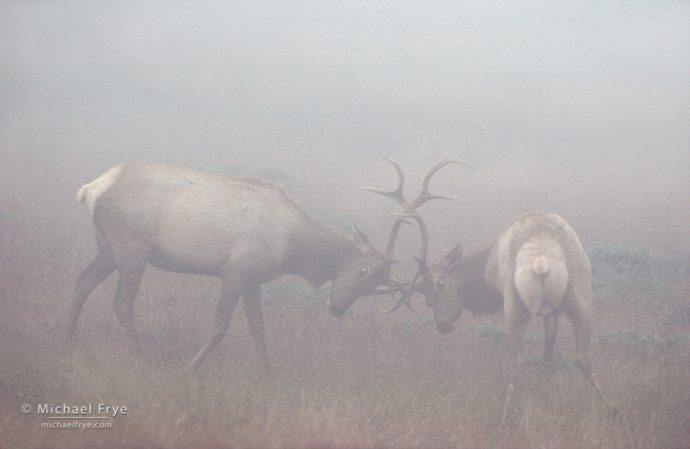
Tule elk bulls in fog, Pt. Reyes National Seashore, California
This photograph is from very deep in my archives: 1988. At that point I had only been photographing seriously for a few years. Claudia and I met in ’84, got married in ’86, and in ’88 were both working at The Ansel Adams Gallery and living in Yosemite Valley.
In those early years the main focus of my photography was wildlife. I also photographed landscapes and other nature subjects, but wildlife was my passion. I used to spend hours in the wonderful Yosemite Research Library, reading studies about wildlife habitats and animal behavior.
(more…)
by Michael Frye | Aug 2, 2020 | Night Photography, Travels and Stories
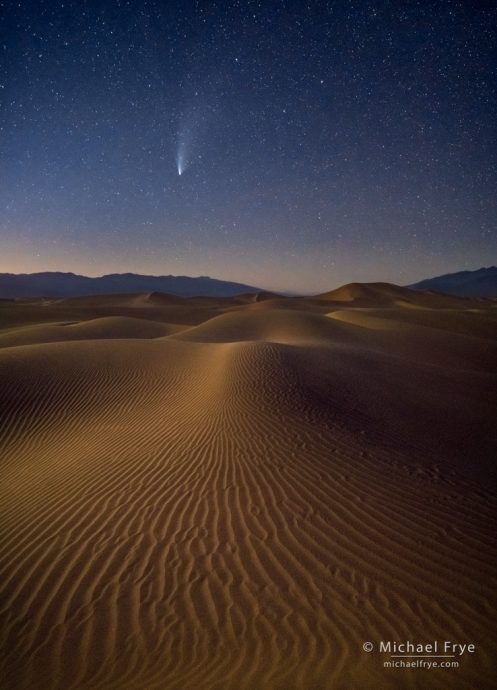
Comet NEOWISE over moonlit sand dunes, Death Valley. 20mm, 16 frames blended to reduce noise, each frame 15 seconds at f/2.4, ISO 6400.
I knew it would be hot. It was July, after all, and Death Valley is perhaps the hottest place on earth. But I was actually lucky; summer temperatures in Death Valley often climb above 120 degrees Fahrenheit, while the high temp on the day I was there was only 113. Practically a cold snap.
What was I doing in Death Valley in July? Photographing Comet NEOWISE of course. I know the internet has been flooded by comet images lately, but I totally get it. The last really photogenic comet visible in the northern hemisphere was Hale-Bopp in 1997. Who knows when we’ll see another one?
(more…)
by Michael Frye | Jul 8, 2020 | Travels and Stories, Yosemite Photo Conditions
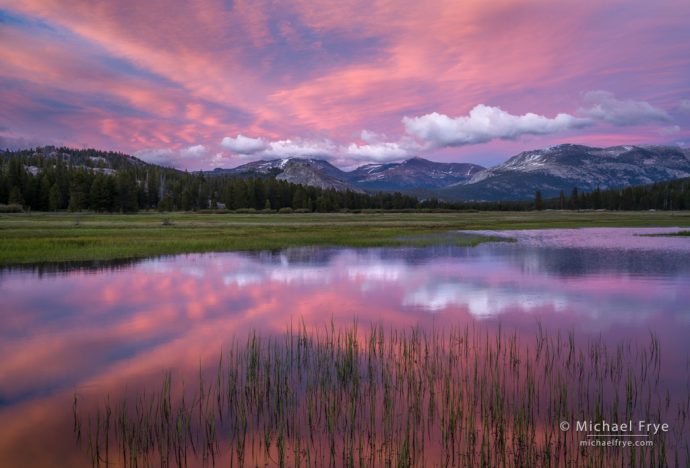
Sunset, Tuolumne Meadows, Yosemite. 35mm, 1/4 sec. at f/16, ISO 200.
It seems like a normal summer in the Yosemite high country. It’s less crowded than usual, since the park has limited the number of people allowed in. But the plants and animals are going about their business as they typically do. Creeks and rivers continue to flow. Clouds sometimes float by. It’s all serenely beautiful.
The park reopened on June 11th, with lodging, camping, or day-use reservations required for entry. After being away for three months, Claudia and I wanted to visit the park on that first day, and were able to secure a day-use reservation.
(more…)
by Michael Frye | Oct 13, 2019 | Light and Weather, Travels and Stories
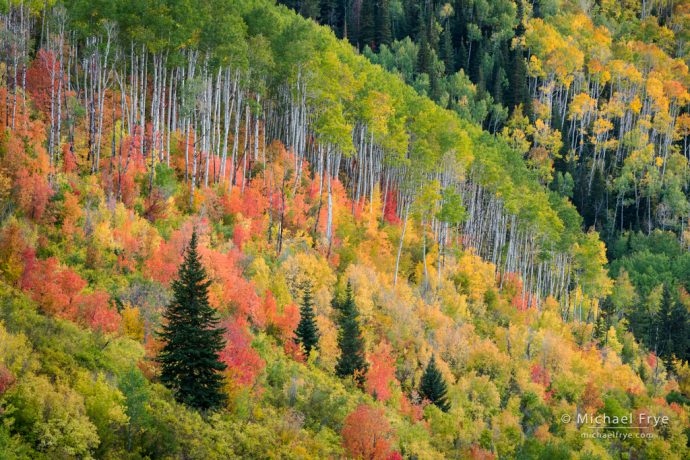
Autumn kaleidoscope, northern Utah. The upper-right portion of this photograph didn’t go into the shade until dusk, so I concentrated on photographing other things for awhile (like the next two images below). But I thought this was worth coming back to, as I loved the mix of colors and patterns. 180mm, 8 seconds at f/11, ISO 100.
As you can probably tell from my last post, Claudia and I had a great time photographing the maples in northern Utah. We even found some spots where the maples were mixed with aspens! Although 99% of the aspens in the area were still green at that time, I loved the juxtaposition of those greens against the reds and oranges of the maples – along with the white aspen trunks.
It’s great to get clouds, as we did for a couple of the photographs in that previous post from Utah. But we don’t have any control over the weather, so we have to adapt to the conditions. It’s hard to make big, sweeping landscape scenes work without clouds to add interest to the sky, so on sunny days I usually narrow my focus and concentrate on smaller scenes. And there were plenty of those in northern Utah, with the maples, aspens, and cottonwoods creating wonderful patterns, textures, and colors.
(more…)
by Michael Frye | Oct 6, 2019 | Travels and Stories
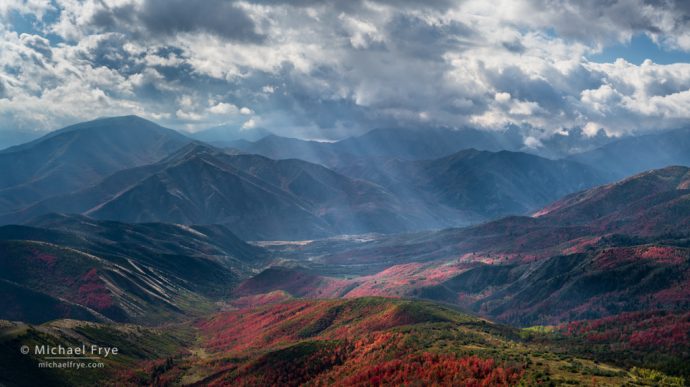
Sunbeams, mountains, and autumn maples, Utah. We were treated to some spectacular sunbeams one morning. Despite the high contrast, I was able to get detail in highlights and shadows with just one exposure. 50mm, 1/250th sec. at f/11, ISO 100, polarizer.
Claudia and I were driving to Colorado when we decided to take a little detour to the Wasatch Mountains in Utah. We’d never been there, and it looked like the bigtooth maples were nearing their peak color, so why not?
The maples, as it turned out, were spectacular, covering the hillsides with red. I’d never seen anything like it. And one day we got treated to some interesting weather, with clouds, mist, and sunbeams.
(more…)
by Michael Frye | Aug 13, 2019 | Travels and Stories
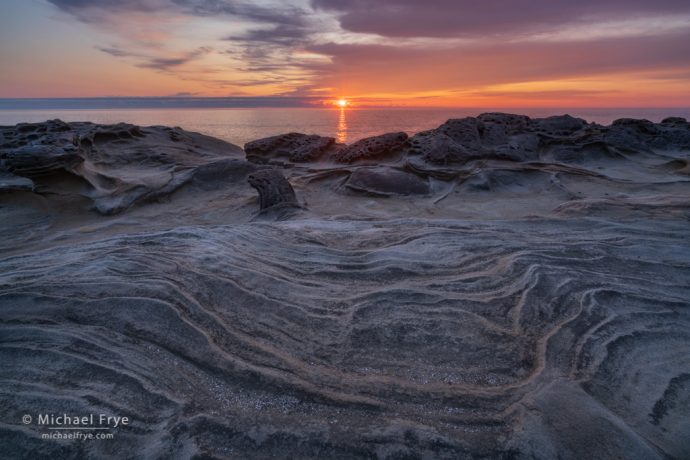
Sunset and sandstone formations, Oregon coast. 16mm, five bracketed exposures at f/16, ISO 100, blended with Lightroom’s HDR Merge, then blended back with one of the original images in Photoshop to eliminate ghosting.
Recently Claudia and I visited our friends Gary and Charlotte Gibb up near Mt. Shasta, where they were renting a house for the week. We had a great time hanging out with them for a couple of days. And then we thought, we’re so close, maybe we should visit the Oregon coast. So we did.
I’ve never spent much time along the Oregon coast, but it’s a beautiful area, and a popular photography destination for a reason, so it’s one of those places that I’ve wanted to explore more thoroughly.
(more…)














